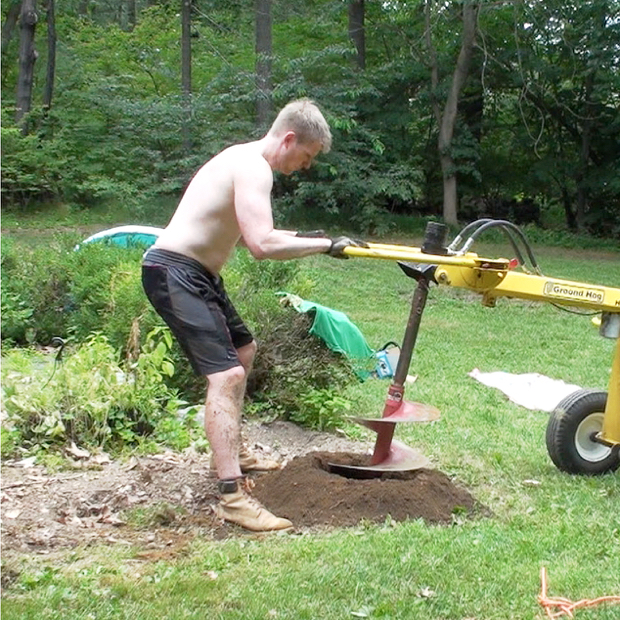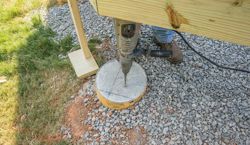Specialist Tips for Setting Up Deck Footings to Assistance Your Outdoor Room
When it involves building a deck, one of the most critical components to consider is the installation of appropriate grounds. These footings are the structure whereupon your outside area will relax, providing security and assistance for several years to come. What precisely does it take to mount deck footings correctly? In this discussion, we will check out professional ideas and techniques that can help make sure a successful and durable deck installment. From picking the best kind of grounds to avoiding typical mistakes, we will offer you with the understanding and insights you require to confidently start your deck-building journey. Let's dive right in and find the key to a long-lasting and solid outdoor area.
Significance of Correct Deck Grounds
Proper deck grounds are necessary for making sure the security and long life of your exterior space. When constructing a deck, it is crucial to take notice of the structure on which it will certainly relax. Deck footings offer the necessary assistance for the entire structure and aid disperse the weight equally - Deck Footings. Without solid and appropriately installed grounds, your deck might come to be unsteady, resulting in safety threats and pricey fixings.

Along with stability, correct deck footings also add to the long life of your exterior room (Deck Footings). Footings that are designed and created to hold up against the elements and soil problems in your area will aid prevent the deck from shifting or resolving with time. By guaranteeing the footings are appropriately sized and set up, you can reduce the threat of damage to the deck structure, extending its life expectancy and decreasing the demand for pricey repair work or substitutes

Picking the Right Sort Of Footings
When selecting the proper sort of grounds for your deck, it is essential to consider elements such as soil conditions, regional building codes, and the overall style of your exterior room. The kind of footing you select will certainly play a crucial duty in making sure the stability and durability of your deck.
One typical sort of ground is the concrete ground. Concrete grounds appropriate for many soil problems and give excellent support for decks. They are typically installed below the frost line to stop shifting and working out as a result of freezing and thawing cycles. An additional choice is helical piers, which are perfect for locations with unstable soil or high water tables. These piers are screwed into the ground and provide solid assistance for the deck.
In many cases, you may need to use specific footings, such as pile grounds or deep foundations, if you are developing a big or multi-level deck. These footings are designed to disperse the weight of the deck over a larger location, ensuring security and protecting against settling or sinking.
Before picking a sort of ground, it is vital to get in touch with local structure codes and laws to make sure compliance. Additionally, think about the design and planned use your outside space. Elements such as the dimension, form, and load-bearing demands of your deck will certainly affect the kind of footing that is most appropriate.
Preparing the Ground for Footing Setup
To correctly prepare the ground for footing installment, it is essential to examine the soil problems and take needed steps to guarantee security and longevity of the click here now deck. The initial action is to excavate the location where the footings will be installed. The deepness of the excavation will certainly depend upon the frost line in your region and the details demands of the deck design. It is important to get rid of any kind of plant life, rocks, or particles from the excavation to make certain a strong foundation.
When the location has actually been excavated, the next step is to small the dirt. This can be done using a plate compactor or by utilizing a hand tamper. Compacting the dirt aids to remove any type of spaces or air pockets, which can bring about working out and instability with time.
After condensing the soil, it is crucial to lay a layer of crushed rock or crushed stone at the base of the excavation. This will supply water drainage and help to avoid water from pooling around the footings, which can cause disintegration and instability.
Step-by-Step Guide to Setting Up Deck Footings
After correctly preparing the ground for footing installation, the following action review is to start the procedure of installing deck footings. This detailed overview will certainly give you with a clear understanding of just how to install deck grounds for your outside room.
Determine the location: Start by noting the settings of the deck grounds utilizing risks and string. Make sure that the areas align with the design and format of your deck.
Dig the holes: Use a message hole digger or an auger to dig the holes for the grounds. The depth and diameter of the holes should remain in accordance with neighborhood building ordinance and the specific requirements of your deck style.
Level the openings: Make use of a degree to make sure that the openings are dug to the correct deepness and are level with each various other. (Deck Footings)
Include gravel: Place a layer of gravel at the base of each opening to enhance drain and prevent the wood from decaying.
Insert the grounds: Position the footings right into the holes, ensuring they are level and plumb. Make use of a degree and a measuring tape to make certain precision.
Protect the footings: Put concrete right into the holes around the grounds, loading them to the top. Utilize a post level to make certain the grounds stay level as the concrete collections.
Enable time for curing: Allow the concrete treatment according to the maker's directions before waging the deck construction.
Usual Errors to Avoid During Footing Setup
One essential facet to think about during the installation of deck grounds is avoiding usual errors that can compromise the stability and longevity of your exterior great site space. While deck grounds may feel like a easy and straightforward component of the building procedure, neglecting certain aspects can lead to expensive repair work and potential safety and security risks down the line.

Furthermore, overlooking to mount appropriate water drainage steps can create water to accumulate around the grounds, resulting in rot, degeneration, and the eventual weakening of the deck's structure. Using the incorrect type of footing material or falling short to properly safeguard the footings can compromise their architectural integrity.
To prevent these errors, it is necessary to seek advice from an expert or follow market standards to ensure appropriate ground installation. By doing so, you can guarantee the stability and durability of your exterior room, giving a delightful and safe environment for years to come.
Final Thought
In final thought, mounting correct deck grounds is important for the security and longevity of your outside room. By picking the appropriate type of grounds and properly preparing the ground, you can make sure a strong foundation for your deck. Adhering to a detailed overview and preventing typical errors during footing installation will further enhance the resilience and safety of your deck.
Correct deck footings are essential for guaranteeing the stability and longevity of your exterior area. The footings serve as a connection in between the ground and the deck, enabling the weight of the deck and its passengers to be distributed uniformly into the dirt.One typical type of ground is the concrete ground. Place the footings: Position the grounds into the holes, making sure they are degree and plumb. Protect the footings: Put concrete right into the openings around the footings, loading them to the top.